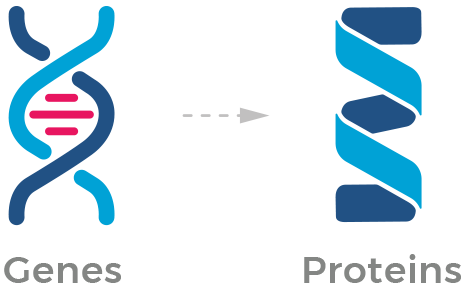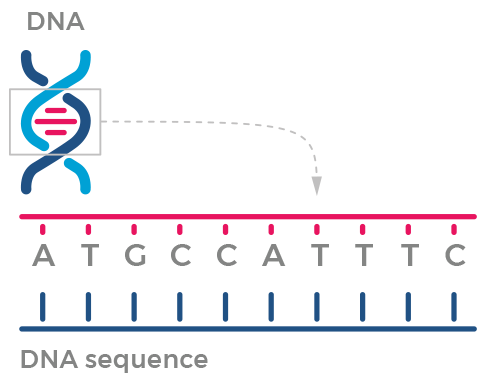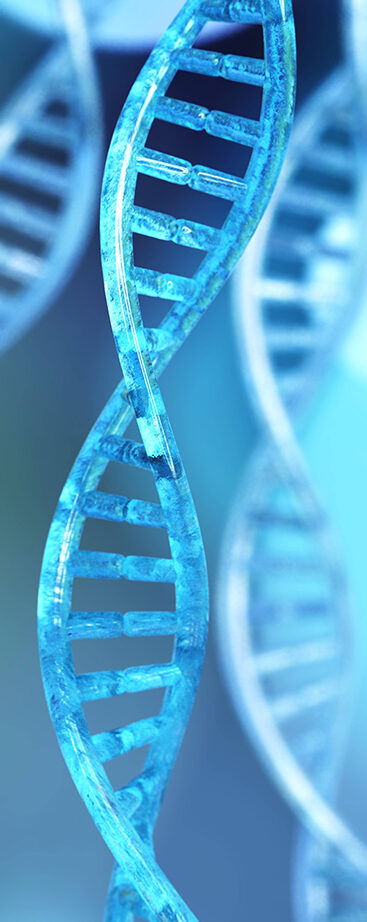Genetics

Genes, Proteins, and DNA
The human body is made up of trillions of cells.
Each cell has a copy of your genome—the total collection of all your genes and DNA.
Genes are instructions that every cell in your body uses to make the proteins they need to function.
Genes can be found in long chains of molecules called deoxyribonucleic acids (DNA) that are twisted together into the shape of a double helix.
There are 4 DNA molecules that are identified by the letters A, T, C, and G. Combinations of these letters make up the genetic instructions that our cells use to make proteins.

DNA Mutations and Disease
Our genes can also be a source of disease.
Small breaks in our DNA are incredibly common and are normally uneventful. DNA breaks can happen from sunlight, for example, or during cell divisions that happen as we grow. Our cells have built-in DNA repair processes that constantly fix these breaks as they occur.
However, breaks are sometimes repaired incorrectly, creating what is known as a mutation. Mutations can occur spontaneously or be passed down from our parents. Mutations can also change how our cells function, and may lead to serious diseases such as sickle cell disease (SCD), Leber congenital amaurosis 10 (LCA10), cancer, and many others.
Genetics

Genes, Proteins, and DNA
The human body is made up of trillions of cells.
Each cell has a copy of your genome—the total collection of all your genes and DNA.
Genes are instructions that every cell in your body uses to make the proteins they need to function.
Genes can be found in long chains of molecules called deoxyribonucleic acids (DNA) that are twisted together into the shape of a double helix.
There are 4 DNA molecules that are identified by the letters A, T, C, and G. Combinations of these letters make up the genetic instructions that our cells use to make proteins.

DNA Mutations and Disease
Our genes can also be a source of disease.
Small breaks in our DNA are incredibly common and are normally uneventful. DNA breaks can happen from sunlight, for example, or during cell divisions that happen as we grow. Our cells have built-in DNA repair processes that constantly fix these breaks as they occur.
However, breaks are sometimes repaired incorrectly, creating what is known as a mutation. Mutations can occur spontaneously or be passed down from our parents. Mutations can also change how our cells function, and may lead to serious diseases such as sickle cell disease (SCD), Leber congenital amaurosis 10 (LCA10), cancer, and many others.
Gene Editing
Gene editing seeks to change DNA sequences within living cells. Gene editing has the potential to correct inherited or acquired genetic errors. To change a DNA sequence, two basic steps are required: first, to locate the DNA sequence of interest, and second, to correct that DNA sequence. We search for specific DNA sequences using proteins that naturally recognize DNA sequences. Several of these proteins can be reprogrammed to recognize a desired DNA sequence, thereby enabling the location of genes with mutations. Mutated DNA sequences can be corrected in many ways, including introducing a controlled DNA break, the most common form of gene editing. This controlled break, referred to as a DNA double-strand break, enables, in general, four types of changes.

Gene therapies.
Gene therapies have the power to treat disease at the DNA level and
address severe unmet medical needs.
At Precision BioSciences. we are focused on applying our proprietary GenomeGO genome-editing technology to cure genetic and infectious diseases where no adequate treatments exist. Gene editing technology has the incredible power to permanently cure devastating diseases; however, because gene edits are permanent, the risk of off-target or off-tissue gene edits can present a significant safety challenge.
Unlike some gene editing technologies that were designed primarily as research tools and subsequently engineered for therapeutic use, GenomeGO was designed with therapeutic safety, delivery and control in mind.
Highly specific GenomeGO platform
Potential to treat a wide range of diseases
Ease of delivery


